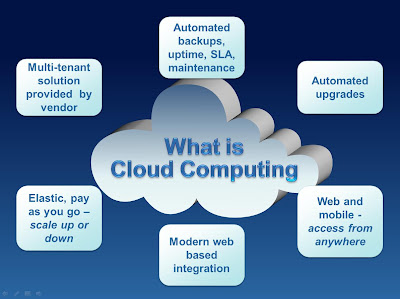Each person is talking about “the cloud”. But what does it
mean?
Cloud computing is the next stage in the Internet's evolution, providing the means through which everything - from computing power to computing infrastructure, applications, business processes to personal co partnership - can be distributed to you as a facility anywhere and every time you need.
 |
| What is Cloud Computing? |
Business applications are moving to the cloud. It’s not just a fashion—the shift from old-style software models to the Internet has gradually increased impetus over the last 10 years. Looking ahead, the next era of cloud computing promises new ways to cooperate in all places, through mobile devices.
The “cloud” in cloud computing can be well-defined as the
set of hardware, networks, storage, services, and interfaces that combine to
deliver features of computing as a service. Cloud services comprise the distribution
of software, infrastructure, and storage over the based on user request.
Cloud computing has four vital features: elasticity and the
ability to scale up and down, self-service provisioning and automatic provisioning,
application programming interfaces (APIs), billing and metering of service
usage in a pay-as-you-go model. This flexibility is what is charming
individuals and trades to change to the cloud.
Life earlier cloud computing
Old-style business applications have always been very complex
and cheap. The expanse and variety of hardware and software mandatory to run
them are daunting. You need a whole team of experts to install, configure,
test, run, secure, and update them.
When you multiply this work across lots or hundreds of apps,
it’s easy to see why the leading companies with the best IT divisions aren't
getting the apps they need. Small and mid-sized businesses don’t stand a
chance.
Cloud computing: a healthier technique
With cloud computing, you remove those headaches because
you’re not managing hardware and software—that’s the duty of a knowledgeable dealer
like Microsoft. The shared infrastructure means it works like a utility:
You only pay for what you need, upgrades are automatic, and scaling up or down
is easy.
Cloud-based apps can be up and running in days, and they
cost less. With a cloud app, you just open a browser, log in, customize the
app, and start using it.
Businesses are running all kinds of apps in the cloud, like
customer relationship management (CRM), HR, accounting, and much more. Some of
the world’s major companies moved their applications to the cloud with cloud
service providers after thoroughly testing the security and dependability of their
infrastructure.
As cloud computing raises in popularity, thousands of firms
are simply re-branding their non-cloud products and services as “cloud
computing.”
Remember: Cloud computing is existing in different forms: public
clouds, private clouds, and hybrid clouds, which combine both public and
private.
Posted by Prashant K Neelratan
Posted by Prashant K Neelratan
0 comments:
Post a Comment